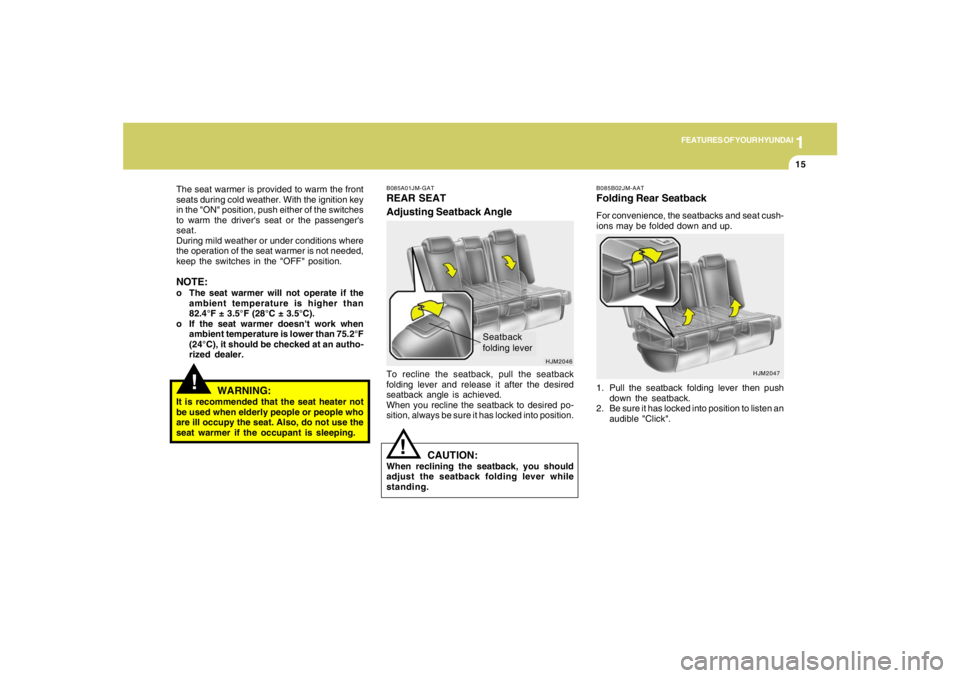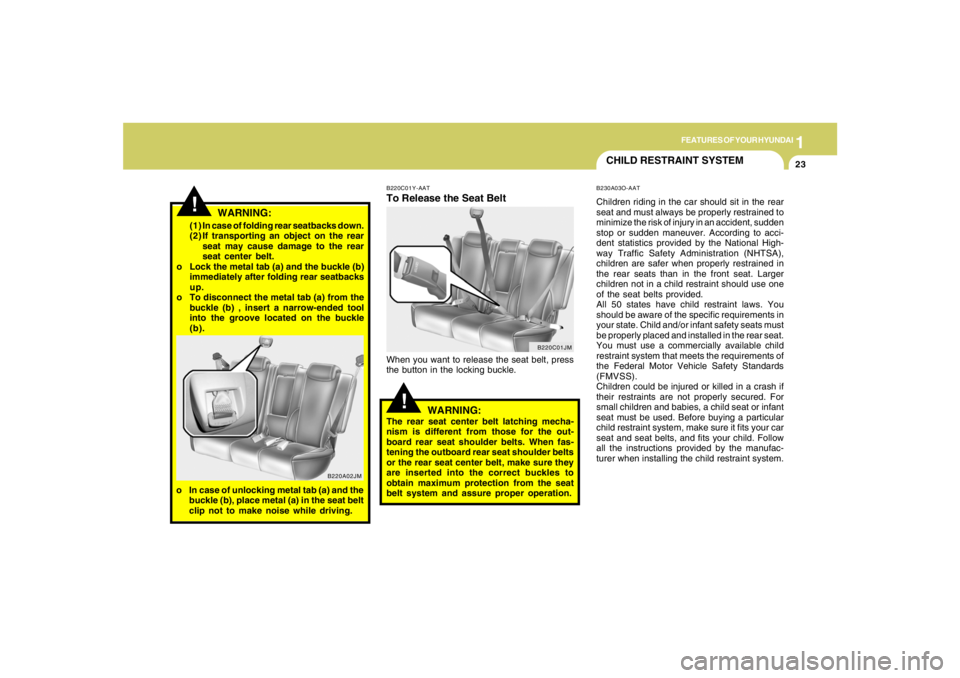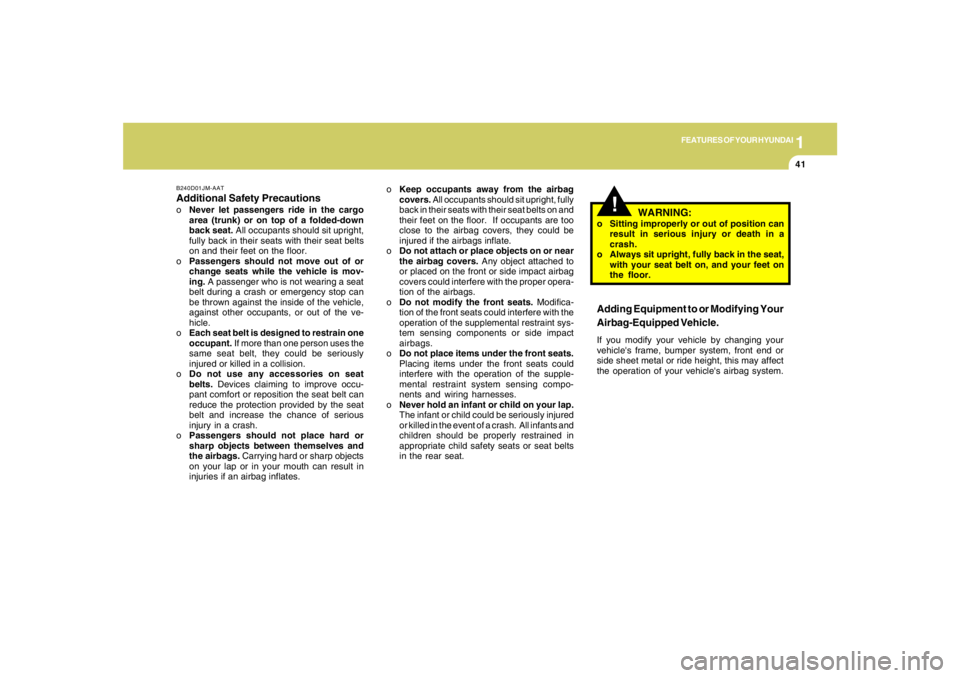2005 HYUNDAI TUCSON fold seats
[x] Cancel search: fold seatsPage 26 of 273

1
FEATURES OF YOUR HYUNDAI
15
!
The seat warmer is provided to warm the front
seats during cold weather. With the ignition key
in the "ON" position, push either of the switches
to warm the driver's seat or the passenger's
seat.
During mild weather or under conditions where
the operation of the seat warmer is not needed,
keep the switches in the "OFF" position.NOTE:o The seat warmer will not operate if the
ambient temperature is higher than
82.4°F ± 3.5°F (28°C ± 3.5°C).
o If the seat warmer doesn't work when
ambient temperature is lower than 75.2°F
(24°C), it should be checked at an autho-
rized dealer.
WARNING:
It is recommended that the seat heater not
be used when elderly people or people who
are ill occupy the seat. Also, do not use the
seat warmer if the occupant is sleeping.
B085A01JM-GATREAR SEAT
Adjusting Seatback AngleTo recline the seatback, pull the seatback
folding lever and release it after the desired
seatback angle is achieved.
When you recline the seatback to desired po-
sition, always be sure it has locked into position.
HJM2046
Seatback
folding lever
!
HJM2047 B085B02JM-AAT
Folding Rear SeatbackFor convenience, the seatbacks and seat cush-
ions may be folded down and up.
CAUTION:
When reclining the seatback, you should
adjust the seatback folding lever while
standing.1. Pull the seatback folding lever then push
down the seatback.
2. Be sure it has locked into position to listen an
audible "Click".
Page 34 of 273

1
FEATURES OF YOUR HYUNDAI
23
!(1) In case of folding rear seatbacks down.
(2) If transporting an object on the rear
seat may cause damage to the rear
seat center belt.
o Lock the metal tab (a) and the buckle (b)
immediately after folding rear seatbacks
up.
o To disconnect the metal tab (a) from the
buckle (b) , insert a narrow-ended tool
into the groove located on the buckle
(b).
WARNING:
CHILD RESTRAINT SYSTEMB230A03O-AATChildren riding in the car should sit in the rear
seat and must always be properly restrained to
minimize the risk of injury in an accident, sudden
stop or sudden maneuver. According to acci-
dent statistics provided by the National High-
way Traffic Safety Administration (NHTSA),
children are safer when properly restrained in
the rear seats than in the front seat. Larger
children not in a child restraint should use one
of the seat belts provided.
All 50 states have child restraint laws. You
should be aware of the specific requirements in
your state. Child and/or infant safety seats must
be properly placed and installed in the rear seat.
You must use a commercially available child
restraint system that meets the requirements of
the Federal Motor Vehicle Safety Standards
(FMVSS).
Children could be injured or killed in a crash if
their restraints are not properly secured. For
small children and babies, a child seat or infant
seat must be used. Before buying a particular
child restraint system, make sure it fits your car
seat and seat belts, and fits your child. Follow
all the instructions provided by the manufac-
turer when installing the child restraint system.
!
B220C01Y-AATTo Release the Seat BeltWhen you want to release the seat belt, press
the button in the locking buckle.
WARNING:
The rear seat center belt latching mecha-
nism is different from those for the out-
board rear seat shoulder belts. When fas-
tening the outboard rear seat shoulder belts
or the rear seat center belt, make sure they
are inserted into the correct buckles to
obtain maximum protection from the seat
belt system and assure proper operation.
B220C01JM
B220A02JM
o In case of unlocking metal tab (a) and the
buckle (b), place metal (a) in the seat belt
clip not to make noise while driving.
Page 52 of 273

1
FEATURES OF YOUR HYUNDAI
41
B240D01JM-AATAdditional Safety PrecautionsoNever let passengers ride in the cargo
area (trunk) or on top of a folded-down
back seat. All occupants should sit upright,
fully back in their seats with their seat belts
on and their feet on the floor.
oPassengers should not move out of or
change seats while the vehicle is mov-
ing. A passenger who is not wearing a seat
belt during a crash or emergency stop can
be thrown against the inside of the vehicle,
against other occupants, or out of the ve-
hicle.
oEach seat belt is designed to restrain one
occupant. If more than one person uses the
same seat belt, they could be seriously
injured or killed in a collision.
oDo not use any accessories on seat
belts. Devices claiming to improve occu-
pant comfort or reposition the seat belt can
reduce the protection provided by the seat
belt and increase the chance of serious
injury in a crash.
oPassengers should not place hard or
sharp objects between themselves and
the airbags. Carrying hard or sharp objects
on your lap or in your mouth can result in
injuries if an airbag inflates.oKeep occupants away from the airbag
covers. All occupants should sit upright, fully
back in their seats with their seat belts on and
their feet on the floor. If occupants are too
close to the airbag covers, they could be
injured if the airbags inflate.
oDo not attach or place objects on or near
the airbag covers. Any object attached to
or placed on the front or side impact airbag
covers could interfere with the proper opera-
tion of the airbags.
oDo not modify the front seats. Modifica-
tion of the front seats could interfere with the
operation of the supplemental restraint sys-
tem sensing components or side impact
airbags.
oDo not place items under the front seats.
Placing items under the front seats could
interfere with the operation of the supple-
mental restraint system sensing compo-
nents and wiring harnesses.
oNever hold an infant or child on your lap.
The infant or child could be seriously injured
or killed in the event of a crash. All infants and
children should be properly restrained in
appropriate child safety seats or seat belts
in the rear seat.
!
WARNING:
o Sitting improperly or out of position can
result in serious injury or death in a
crash.
o Always sit upright, fully back in the seat,
with your seat belt on, and your feet on
the floor.Adding Equipment to or Modifying Your
Airbag-Equipped Vehicle.If you modify your vehicle by changing your
vehicle's frame, bumper system, front end or
side sheet metal or ride height, this may affect
the operation of your vehicle's airbag system.
Page 176 of 273

2
DRIVING YOUR HYUNDAI
30
NOTE:
o Overloading your vehicle may
cause damage. Repairs would not
be covered by your warranty. Do
not overload your vehicle.
o Using heavier suspension com-
ponents to get added durability
might not change your weight rat-
ings. Ask your dealer to help you
load your vehicle the right way.
The label will help you decide how much
cargo and installed equipment your
vehicle can carry.
If you carry items inside your vehicle –
like suitcases, tools, packages, or any-
thing else – they more as fast as the
vehicle goes. If you have to stop or turn
quickly, or if there is a crash, the items
will keep going and can cause an injury
if they strikes the driver or a passenger.
!
WARNING:
Items you carry inside your vehicle
can strike and injure people in a
sudden stop or turn, or in a crash.
o Put things in the cargo area of
your vehicle. Try to spread the
weight evenly.
o Never stack items, like suitcases,
inside the vehicle above the tops
of the seats.
o Do not leave an unsecured child
restraint in your vehicle.
o When you carry something inside
the vehicle, secure it.
o Do not drive with a seat folded
down unless necessary.